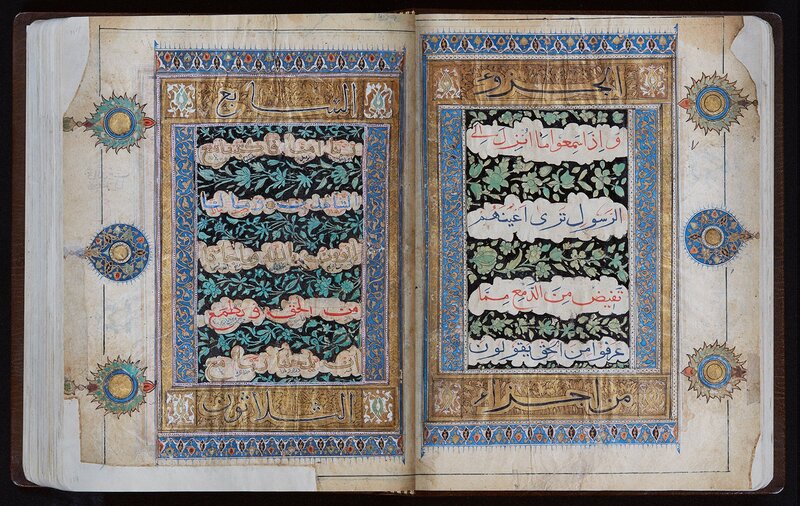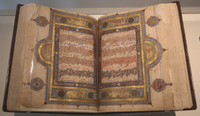Gwalior Qur'an from India
Type:
Illuminated manuscripts,
Qur'ans
Date:
1399
Location or Findspot (Modern-Day Country):
India
Dimensions:
29.8 × 23.5 × 6.6 cm
Description:
This copy of the Qur'an was made in India in 1399. At that time the subcontinent was divided into sultanates (1192–1526); later it would be united under the Mughals (the founder of the Mughal dynasty, Babur, was a Central Asian descendant of the Ilkhanid emir Timur). A colophon relates that the book was completed by Mah'mud Sha'ban in the Gwalior Fort soon after Timur invaded India and sacked Delhi in 1398. In these years Gwalior was ruled by a Hindu dynasty, but there must have been a Muslim population as well, including refugees from Delhi. The Qur'an is a rare dated and signed work from the Indian Sultanate period.
Among its 550 folios, the Gwalior Qur'an contains thirty-four lavish double-page illuminations (carpet pages) that mark section divisions (into thirty parts, to be read over one month, and into four quarters). The multicolored Bihari script—with an emphasis on the horizontal parts of letters and written in blue, red, and gold ink—was used only in India for Arabic religious texts. The Qur'an also contains a Persian translation between the Arabic lines, multiple commentaries, and, at the end of the book, a text about using the Qur'an for divination (a Falnama). Using the Qur'an to make predictions was a very old practice, but this is the earliest preserved Falnama text.
Among its 550 folios, the Gwalior Qur'an contains thirty-four lavish double-page illuminations (carpet pages) that mark section divisions (into thirty parts, to be read over one month, and into four quarters). The multicolored Bihari script—with an emphasis on the horizontal parts of letters and written in blue, red, and gold ink—was used only in India for Arabic religious texts. The Qur'an also contains a Persian translation between the Arabic lines, multiple commentaries, and, at the end of the book, a text about using the Qur'an for divination (a Falnama). Using the Qur'an to make predictions was a very old practice, but this is the earliest preserved Falnama text.
Relevant Textbook Chapter(s):
10
Repository and Online Resources:
• The Gwalior Qur'an is in the collection of the Aga Khan Museum, Toronto.
• Watch a short video about the Gwalior Qur'an on the Khamseen website.
Image Credits:
Adam S. Cohen; Aga Khan Museum




